Empire Total War: Infantry - part 2
Fighting with bayonets
There is a big risk that the enemy - seeing that he cannot deal with you with muskets - will run to you and start fighting on bayonets. And the battle is changing its character and begins to look like a medieval battles from Medieval II. You can either engage your units that have not been attacked to melee combat or pull them back to the appropriate distance and shoot.
Sometimes you will be forced to use bayonets in combat. Always try to attack the enemy with more units than he has (you can even send two regiments for one hostile group).
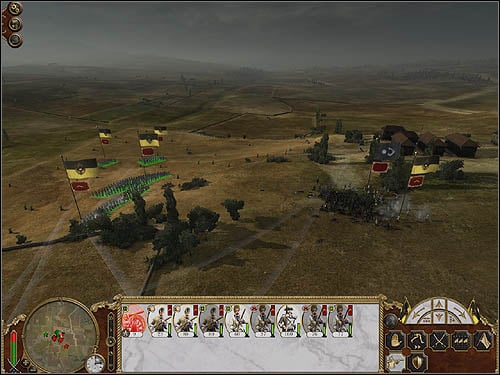
Is good to use bayonets when attacking artillery too. I will not recommend you a frontal attack (your soldiers will be massacred by the cannister missiles). Try to run up to the enemy cannons from the flank or from the back. Even when you will have 80 soldiers in the regiment you should be able to defeat artillerists (because they are in much smaller groups).
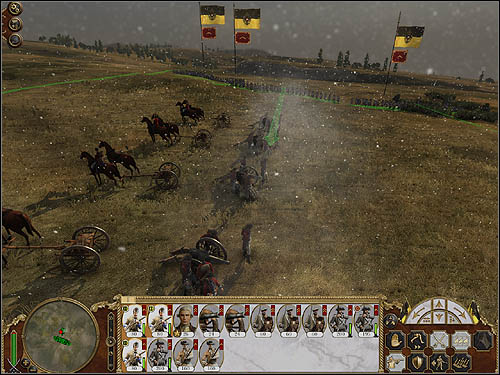
Bayonets may be also useful when your opponent is hiding behind some low walls. Its obvious that the musket fire is completely useless in that case. You can surround enemy soldiers or run up to them, jump over the wall kill them with knives. The decision should depended on the type of your forces and their combat experience.
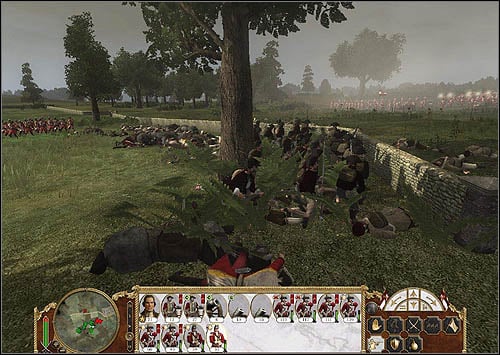
I do not recommend hiding your army behind the walls, especially when you have Fire by Rank technology. While hiding, you protect your people from the opponents bullets, but at the same time you're reducing strength of your firepower.
The more time you're spending in the game, the more things you're learning about your units. If you are aware that the units in the hostile army have better firepower than yours, then attack them with bayonets (so they wouldn't be able to take advantage of their strength).
Achieving victory
When you notice that you are gaining an advantage over the enemy, order your regiments to attack hostile units from the flanks. As a matter of fact, you will create a semicircle around the enemy soldiers and the firepower of your units will be even more effective. Look at the picture below: the conclusion in this situation is almost foregone.
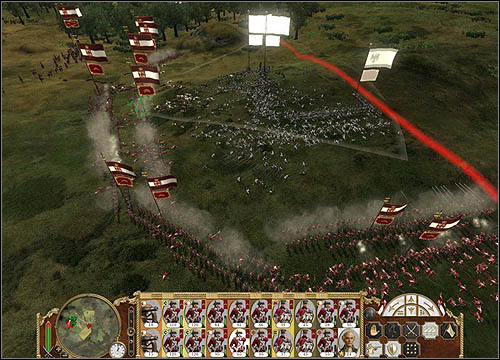
Make sure that part of one regiment is not standing in front of the next one (they can accidentally shoot themselves). It's possible that the opponent (in the situation shown in the picture above) will try to run away. Shoot deserters in the back.
Infantry special abilities
There are some infantry units with a very unique abilities. These includes Grenadiers, Light Infantry, Jeagers, etc.
Grenades - Grenadiers are equipped with explosives which are very effective in the combat. There is only one condition - the opponent cannot move. Throwing grenades takes couple of seconds and, in addition, charges need some time to explode. Use it when your opponent is busy (for example with reloading a weapons). One of the best targets for Grenadiers are large regiments of musketeers. They usually move in a very tight formation, so grenades may hurt many soldiers at a time. The same applies to artillery - not only that it is not very mobile, but also explosions can completely destroy the enemy cannons.
Please note that the range of grenades is much shorter than the range of Grenadiers weapons. So you have to have a moment to run close to the enemy. It also means that the formation of your troops will be destroyed for a moment.
Stakes - when your opponent has a plenty of horsemen units is almost certain that he will try to charge. Sharpened stakes, deployed by the light infantry (for example) will calm down his enthusiasm, and reduce moving abilities of his cavalry. Palisade is a defensive structure, so if you are going to run up to your enemy and fight then there is no sense of making it (it takes a bit of time that can be spend on other, more effective actions). As a substitute, I recommend square formation and bayonets.
Light Infantry Behavior - when playing with light infantry, you can either keep them in tight or loose formation. In the second one, your troops are more likely to survive when the enemy artillery is shooting. However, keep in mind that after that kind of run your regiments will need couple of seconds to regroup.
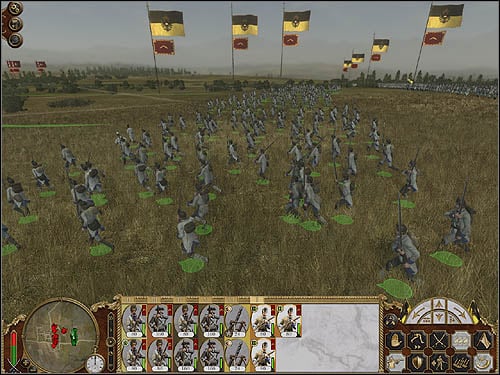
Hiding
Many units have a special ability to hide in the woods, high grass, etc. Among these troops is light infantry and units that can be used to disturb and harass the enemy army, such as Rangers, Courers de Bois, and Siberian Hunters.
These troops can be deployed on the battlefield in several ways. You can put them before the main army and wait for the enemy. Attack suddenly and go back to your main regiments - that strategy may confuse your enemy.
There is also a second strategy: put your main army in the back and deploy hiding troops on the flanks. This situation is presented on the picture below. Turkish forces are standing in one line and waiting for the enemy. Bashi-Bazouks armed with sabers are waiting for the enemy infantry..
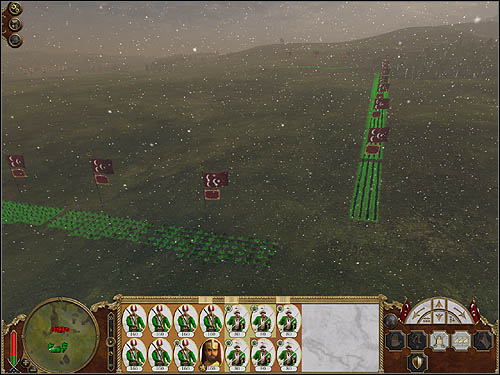
Fighting using a rabble
In the battle sometimes you have to use rabble (there are plenty of them but they're quite bad in fighting), for example: Musellims or Firelock Armed Populace. Note that units that do not have very good statistics can be used to perform some minor tasks.
The first one is to eliminate hostile artillery. Cannons are operated by a small number of artillerists, so even a large number of peasants armed with pitchforks can handle then. As you know, at the near Raclawice Kosciuszko used such a rubble to eliminate the Russian artillery.
Another task for canaille may be to stop the enemy infantry for the short period of time. The group of peasants can fight and delay hostile units. That time can be spent on deploying your artillery, or sticking stakes against enemy cavalry, etc.
Eventually, these forces can be used as a support for the regular troops of your army. Try not to do it too often, because rabble will be always the weaker point in your army. When the enemy is fighting with bayonets the mob should be fighting too (mainly because of their number), but do not expect sensations here.
Defeat
When you notice that the opponent is gaining a significant advantage on the battlefield, I suggest quickly end the fight and withdraw your troops. When the battle will be completed, your units will have a chance to move to another location on the campaign map and regroup (under condition that they were not retreating earlier in the same turn).

You are not permitted to copy any image, text or info from this page. This site is not associated with and/or endorsed by the developers and the publishers. All logos and images are copyrighted by their respective owners.
Copyright © 2000 - 2025 Webedia Polska SA for gamepressure.com, unofficial game guides, walkthroughs, secrets, game tips, maps & strategies for top games.
